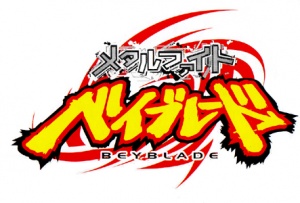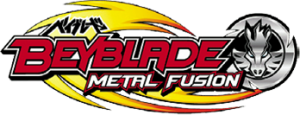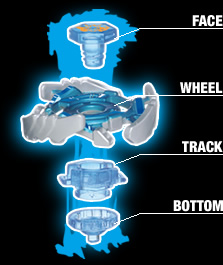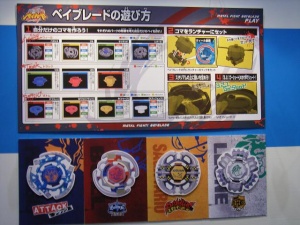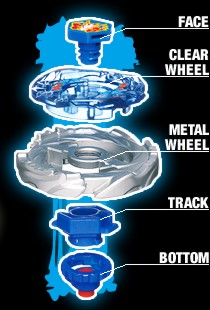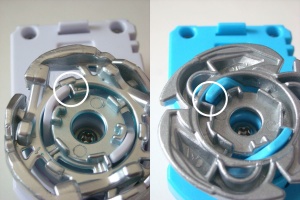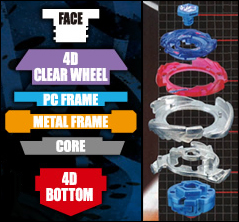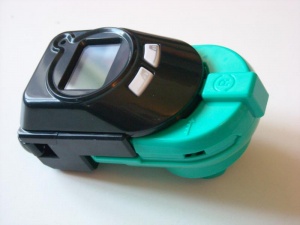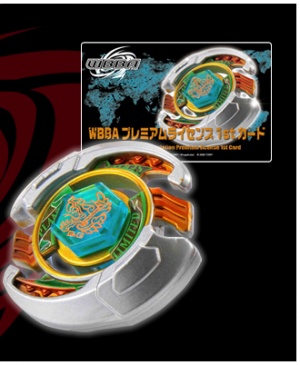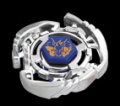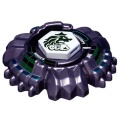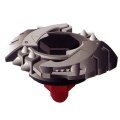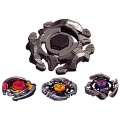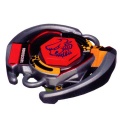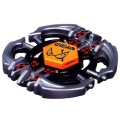Difference between revisions of "Metal Fight Beyblade"
(Removing some unauthorized additions from times long past.) |
|||
| (81 intermediate revisions by 23 users not shown) | |||
| Line 1: | Line 1: | ||
| − | [[Image: | + | [[Image: MetalFightBeyblade_Logo1.jpg|thumb| Metal Fight Beyblade logo]] |
| − | + | [[Image: BeybladeMetalFusionLogo1.png|thumb|Beyblade: Metal Fusion logo]] | |
| + | In ''April 2008'', [[TAKARA-TOMY]] announced the return of the Beyblade toyline with a completely new series called '''Metal Fight Beyblade''' (MFB) in Japan, after having suspended production in 2005. This new series is targeted towards a whole new generation of kids. The first releases were in stores around ''August 9th 2008''. To gain a wider audience, a manga drawn by Adachi Takafumi, an anime and a Nintendo DS game that feature a whole new cast of characters have since been released, and sales have only been increasing. A new official organization called World BeyBlade Association (WBBA) constantly hosts tournaments in Japanese shops and in bigger events, such as the bi-annual World Hobby Fair. In a recent press release, TAKARA-TOMY indirectly revealed that Metal Fight Beyblade should be active, perhaps outside Japan, until 2012. | ||
| − | + | Starting in ''spring 2010'', Hasbro began distributing '''Beyblade: Metal Fusion''' in Canada, and ''fall 2010'' in the United States and UK. It is unknown at the moment whether other countries will get the new beyblades around the same time. | |
| − | + | On March 28 2011, TAKARA-TOMY released the third series of MFB, '''Metal Fight Beyblade 4D'''. In 2011, Hasbro released the second Metal Fusion series under the name '''Beyblade: Metal Masters'''. | |
__TOC__ | __TOC__ | ||
| − | |||
==Components of MFBs== | ==Components of MFBs== | ||
[[Image:MFBparts.jpg|thumb| Components of MFB]] | [[Image:MFBparts.jpg|thumb| Components of MFB]] | ||
[[Image:MFBchart.jpg|thumb|MFB Chart]] | [[Image:MFBchart.jpg|thumb|MFB Chart]] | ||
| − | + | Before the beginning of the anime in April 2009, Metal Fight Beyblades were constituted of four parts in what was known as the '''Metal System''': | |
| − | *'''Face:''' Hexagonal screw-like piece that fastens the Beyblade together, similar to [[Bit Protector]] from the [[HMS]]. They feature graffiti-style illustrations on the top (i.e. Bull, Pegasis, etc). | + | *'''Face/Face Bolt:''' Hexagonal screw-like piece that fastens the Beyblade together, similar to [[Bit Protector]] from the [[HMS]]. They feature graffiti-style illustrations on the top (i.e. Bull, Pegasis, etc). With the introduction of the Hybrid Wheel System also came the Metal Faces, which are 3.5 grams heavier than normal Faces, therefore they help add weight to a Beyblade. From BB-27 through BB-46, Faces are blank, and stickers must be applied to them. Starting from BB-47, Faces became printed again up until BB-105, when they were once again made blank. |
| − | *'''Wheel:''' Main source of attack from a Beyblade; unlike HMS, the Wheel is completely made out of metal to compensate for the lack of a Weight Disk. They use various shaped protrusions to lower the [[spin velocity]] of an opponent. The Wheel is fundamentally the same as the Attack Ring from the HMS and [[Plastic Beyblade | plastic Beyblades]]. The shooter connects directly to the Wheel and does not depend on the Face or the Track for a solid connection. The Wheel | + | *'''Wheel:''' Main source of attack from a Beyblade; unlike HMS, the Wheel is completely made out of metal to compensate for the lack of a Weight Disk. They use various shaped protrusions to lower the [[spin velocity]] of an opponent. The Wheel is fundamentally the same as the Attack Ring from the HMS and [[Plastic Beyblade | plastic Beyblades]]. The shooter connects directly to the Wheel and does not depend on the Face or the Track for a solid connection. The Wheel determines the spin direction of the Beyblade. |
| − | *'''Track:''' The Track is the component of the Beyblade that connects the Wheel and Bottom. The Track determines the height of the Beyblade. Their names (when read with a decimal before the last digit) determine their height in millimeters. For example, Pegasis' Track is called 105, which stands for 10.5 MM. | + | *'''Track/Spin Track:''' The Track is the component of the Beyblade that connects the Wheel and Bottom. The Track determines the height of the Beyblade. Their names (when read with a decimal before the last digit) determine their height in millimeters. For example, Pegasis' Track is called 105, which stands for 10.5 MM. Some Tracks have gimmicks which help make multiple good customizations since some of them are significantly heavier than others, like Flame Sagittario’s C145 Track. |
| − | *'''Bottom:''' The bottom of the Beyblade. It has interchangeable tips which the Beyblade spins on. Movement patterns can be altered with the differently shaped tips that can be used. It is similar to the Blade Base from plastic Beyblades or the Running Core from HMS. | + | *'''Bottom/Performance Tip:''' The bottom of the Beyblade. It has interchangeable tips which the Beyblade spins on. Movement patterns can be altered with the differently shaped tips that can be used. It is similar to the Blade Base from plastic Beyblades or the Running Core from HMS. The Bottom is indicated by the (sometimes two) last letter(s) of a Beyblade’s name: for instance, Capricorne 100HF, where HF is the Bottom and stands for Hole Flat. |
| + | |||
| + | Faces and Bottoms are screwed onto the Tracks by using a Tool, which resembles an assembling key. One of its side is hexagonal-shaped to fit around the Face, and the opposite side is more round. | ||
| + | |||
| + | ===Hybrid Wheel System=== | ||
| + | Coinciding with the release of the anime in April 2009, a new system was introduced which has five components instead: the ''Hybrid Wheel System'' (HWS). The structure is very similar to the four-parts system, but it differs in that the Wheel is now separated into two: [[Image: hws.jpg|thumb| Hybrid Wheel System]] | ||
| + | *'''Clear Wheel/Energy Ring:''' Upper part of the Hybrid Wheel which is made of clear polycarbonate, a kind of plastic that is supposed to be more resistant than normal. All plastic parts of a Metal Fight Beyblade are made out of that plastic. Unfortunately, most Clear Wheels rarely get to make a good impact in the game unless there is a significant height difference between two Beyblades; only the L Drago, Perseus and Meteo L Drago Clear Wheel obviously comes into play, as it is wider and that it actually extends to cover the Metal Wheel. However, Clear Wheels are mostly different because of their slight weight variations and the area they cover on the Metal Wheel. | ||
| + | *'''Metal Wheel/Fusion Wheel:''' As the name indicates, it is basically a thinner metal equivalent of the normal Wheel. The Metal Wheel mostly determines the weight of the Hybrid Wheel, as well as the type of attack of the beyblade because it is usually wider than the Clear Wheel. | ||
| + | |||
| + | Together, the Clear and Metal Wheels’ weight is equivalent to that of a normal Wheel. Also, the Clear Wheel is the second part of a Hybrid Wheel name, while the Metal Wheel comes first: for example, Storm Pegasis – Storm is the Metal Wheel, Pegasis is made of plastic. | ||
| + | |||
| + | TAKARA-TOMY also released Random Booster Light Volumes in which the Metal Wheels are replaced by Light Wheels: most of those are the plastic equivalent of already existing Metal Wheels. There is no point in using Light Wheels competitively unless only that type of Wheel is used. Because of the huge drop in weight the different material causes, Light Wheel Beyblades do not spin for as long as normal Beyblades.[[Image:Spindirectionwalls.jpg|thumb|The walls that disable shooters of the opposite spin direction from working on certain Beyblades are circled]] In short, Random Booster Light Volumes are mostly an opportunity to get Clear Wheels, Tracks and Bottoms of different colours, or special parts that only come with the prize Beyblade of the Random Booster. | ||
| + | |||
| + | A special note must be made about left-spin Wheels: not only do they require a special launcher currently not sold separately, but, in the case of Hybrid Wheels, left-spin Clear Wheels and Metal Wheels are incompatible with the ones that spin in opposite direction. That is both due to small ‘walls’ in the Clear Wheels where the hooks of the launcher are supposed to be inserted, and another, parallel wall on the Metal Wheel that prevents the opposite spin launcher’s hooks from getting under the Clear Wheel. In other words, at the moment, the Lightning Metal Wheel and the L Drago Clear Wheel, the Meteo Metal Wheel and the L Drago II Clear Wheel, and the Destroy Metal Wheel and L Drago III Clear Wheel are exclusive to each other, while all the other Clear Wheels and Metal Wheels are interchangeable amongst each other. | ||
| + | |||
| + | ===4D System=== | ||
| + | Starting in April 2011, a new system, called "4D", was introduced. Its name is based on four expressions beginning with D's: | ||
| + | *'''Different Material''' | ||
| + | While 4D Metal Wheels are still made of the same zinc alloy with [[TAKARA-TOMY]] as far as is known and that plastic parts still use Polycarbonate, the 4D Clear Wheels include some metal powder in them, even though they are not considerably heavier than regular Clear Wheels. | ||
| + | *'''Divided Wheel''' | ||
| + | One of the biggest features of the 4D System is the fact that each Metal Wheel has at least two parts which can change modes at least once, almost always by rotating its pieces or even flipping them. | ||
| + | *'''Dynamic Drive''' | ||
| + | The 4D Bottoms have automatic and usually dynamic mode changes. | ||
| + | *'''Deep Custom''' | ||
| + | The possibilities for inner customization with the divided Wheels have increased. | ||
| + | |||
| + | <br>The parts of a full 4D Beyblade are therefore: | ||
| + | [[Image: MFB_4DParts.jpg|thumb| 4D System]] | ||
| + | *'''Face''' | ||
| + | *'''4D Clear Wheel:''' The new type of Clear Wheel is essentially just like any other Clear Wheel from the Hybrid Wheel System, but some metal powder was included within the Polycarbonate. These are consequently compatible with every other Beyblade after the Metal System. | ||
| + | *'''4D Metal Wheel:''' To be considered a 4D Metal Wheel, a Wheel must be divided into at least two parts which can be moved to change modes. For instance, Big Bang has three parts which are called the PC Frame, the Metal Frame, and the Core. A total of four different modes can be built by simply rotating either of the pieces by just a few degrees. The Core is usually the lowest part of the 4D Metal Wheel, and it is the piece that has the small 'walls' that prevent the insertion of launchers' prongs that spin in the opposite direction, and it connects with the Track if one is used in the combination. The (Metal) Frame belongs right on top of the Core, and it normally has the appropriate shape to hold the Clear Wheel. Finally, the PC Frame is made of Polycarbonate, and acts as a smaller equivalent of a Clear Wheel while not replacing it. Not all 4D Beyblades have a PC Frame however, and it only attempts to absorb some more shocks along with the Clear Wheel. A 4D Metal Wheel's inner pieces are '''incompatible''' with another 4D Metal Wheel's, hence why each piece is not clearly indicated in the Beyblade naming system: for example, Fang has two parts, but is only called by one word. When referring to the placement of the inner pieces of a 4D Metal Wheel, the mode is simply said. | ||
| + | *'''4D Bottom:''' Also known as Bottom, or Fusion Bottom, but those names are less popular and less official. A fusion of the usual Track and Bottom, the 4D Bottoms include multiple functions that wouldn't be possible on a normal Bottom or Track, such as an automatic tip change which depends on the Beyblade's velocity, a manual tip change involving 3 different tips, and a bearing tip. The mechanism inside the automatic tip change has the purpose of beginning with a certain tip when the Beyblade is launched and spins with full power, and then either making that tip retract or have another one come out when it reaches a lower [[spin velocity]]. The change must be automatic, otherwise it is illegal. To compensate for the lack of a Track part, 4D Bottoms are generally as high as a 145 Track and a Bottom with an average height. They are additionally quite large and therefore heavier than normal parts. | ||
| + | |||
| + | While the lower number of parts and the inability to interchange the 4D Metal Wheel parts between themselves are a frequent subject of complaint from Bladers who are worried about customization, a whole new aspect is still developed with the multiple mode changes involved with these new parts, and not all Beyblades introduced in the 4D System are full 4D Beyblades, so new Tracks and Bottoms are still produced. | ||
| + | |||
| + | As always, left-spin-capable Beyblades have special Wheels made to only work on their own, and new gimmicks such as the absence of a Clear Wheel were made. | ||
| + | |||
| + | While releasing new versions of old Beyblades, the 4D Series is heavily inspired by the planets from our solar system for the most part, as well as some of the remaining constellations. | ||
===Types=== | ===Types=== | ||
| − | There | + | There are four different types of MFBs: |
*[[Survival | Stamina]] | *[[Survival | Stamina]] | ||
*[[Balance]] | *[[Balance]] | ||
| Line 26: | Line 63: | ||
===Size Difference=== | ===Size Difference=== | ||
| − | Metal Fight | + | Metal Fight Beyblades are smaller than [[Plastic Beyblade | plastic generation]] Beyblades, and about the same size as those of the [[HMS]] series. |
==Shooter and Beypointer== | ==Shooter and Beypointer== | ||
[[Image:BeypointerShooter_800x600.jpg|thumb|MFB Shooter with Beypointer attached]] | [[Image:BeypointerShooter_800x600.jpg|thumb|MFB Shooter with Beypointer attached]] | ||
| − | + | There are currently five types of launchers: the Right light Launcher; the [[BeyLauncher]], a string shooter which allows for a more powerful launch; and the Beylauncher-L (also called Launcher L), which is exclusive to left-spin beyblades and is only sold with L-Drago 105F, Lightning L-Drago 100HF, and Meteo L-Drago LW105LF, a Light Launcher-L that comes with L Drago Destroy and finally the Beylauncher LR which is able to spin Beyblades in either direction. Some exclusive launchers were released by Hasbro too: The "Rev up Launcher" and the "Wind and shoot Launcher". A [[MFB Shooter#Beypointer | Beypointer]] was also released as a device that records your points from battles, and a few accessories were developed to help ease the player's grip on the launchers. | |
==Stadiums== | ==Stadiums== | ||
| − | + | Multiple stadiums have been released, some of which are comparable to the Takara HMS ones, and others that are more innovative like Wide Square and Super Attack. | |
| + | The BB-10 Attack Type BeyStadium is recommended by most. | ||
| − | + | *'''Full List of MFB Stadiums''' | |
| − | |||
| − | + | Hasbro: Pegasus Thunder Whip, Mobile Stadium, Super Vortex Stadium, Max Stampede, Lightning Force, Bolt Blast, Burning Firestrike, Triple Battle, Striker, and Destoyer , Kerbex | |
| − | + | Takara Tomy: Attack Type, Balance Type, Stamina Type, Wide Square Type, Super Attack, Tornado Type, Extreme Type. | |
| − | |||
| − | |||
| − | |||
| − | |||
| − | |||
| − | |||
| − | + | SonoKong:Triple Type Stadium. | |
| − | |||
| − | |||
| − | |||
| − | |||
| − | + | ==WBBA== | |
| − | + | The WBBA (World BeyBlade Association) is an association being run by TAKARA-TOMY to promote Metal Fight Beyblade, by holding tournaments and giving away prizes to Beybladers who achieve a certain amount of points using the Beypointer. | |
| − | |||
| − | |||
| − | |||
| − | |||
| − | |||
| − | |||
| − | |||
| − | |||
| − | |||
| − | |||
| − | |||
| − | |||
| − | |||
| − | |||
| − | |||
| − | |||
| − | |||
| − | |||
| − | |||
| − | |||
| − | |||
| − | |||
| − | |||
| − | |||
| + | WBBA shops can be found in numerous Japanese toy stores. These give access to a Bey Tai 1 arcade machine, which allows players to test beyblades and win prizes. | ||
===Limited=== | ===Limited=== | ||
[[Image:Wbbadragon.jpg|thumb| WBBA Limited Beyblade, Quetzalcoatl]] | [[Image:Wbbadragon.jpg|thumb| WBBA Limited Beyblade, Quetzalcoatl]] | ||
| − | *TAKARA-TOMY also released BB-00 Pegasis Prototype. It is a silver version of Pegasis which is either without paint or simply bare die cast. Since it is event exclusive, this Beyblade cannot be purchased officially through online stores. Japanese people | + | *TAKARA-TOMY also released BB-00 Pegasis Prototype. It is a silver version of Pegasis which is either without paint or simply bare die cast. Since it is event exclusive, this Beyblade cannot be purchased officially through online stores. Japanese people could however easily get one by either going to the World Hobby Fair 2008 or by playing on the GanGan Stadium arcade machine (Bey Ta 1 Go) and winning three consecutive matches. |
| − | *TAKARA-TOMY | + | *TAKARA-TOMY rewarded players in Japan with a special, limited edition Beyblade (Quetzalcoatl 90WF (08/2008-08/2009) and Anubis (08/2009-08/2010)) for obtaining a certain amount of points (15000) through battling other players in the WBBA and collecting five sub-licence cards and getting a premium licence card. |
| − | ===Gallery | + | ==Initial releases== |
| + | *BB-01 Starter [[Pegasis 105F]] ''(August 9th, 2008)'' | ||
| + | *BB-02 Starter [[Bull 125SF]] ''(August 9th, 2008)'' | ||
| + | *BB-03 Starter [[Sagittario 145S]] ''(August 9th, 2008)'' | ||
| + | *BB-04 Starter [[Leone 145D]] ''(August 9th, 2008)'' | ||
| + | *BB-05 Booster [[Pegasis 105F#Other Versions|Pegasis]] 145D ''(August 9th, 2008)'' | ||
| + | *BB-06 Booster [[Bull 125SF#Other Versions|Bull]] 145S ''(August 9th, 2008)'' | ||
| + | *BB-07 Booster [[Sagittario 145S#Other Versions|Sagittario]] 125SF ''(August 9th, 2008)'' | ||
| + | *BB-08 Booster [[Leone 145D#Other Versions|Leone]] 105F ''(August 9th, 2008)'' | ||
| + | *BB-09 [[Pegasis DX Set]] ''(August 9th, 2008)'' | ||
| + | *BB-10 [[BeyStadium Attack Type (MFB)|BeyStadium Attack Type]] ''(August 9th, 2008)'' | ||
| + | |||
| + | [[MFB Product List|Complete list of Metal Fight Beyblade releases]] | ||
| + | |||
| + | ==Gallery== | ||
<gallery> | <gallery> | ||
| − | + | Image:Pegasus00Prototype.jpg|BB-00 Pegasis Prototype | |
| − | |||
| − | |||
| − | |||
| − | |||
| − | |||
| − | |||
| − | Image:Pegasus00Prototype.jpg|Pegasis Prototype | ||
| − | |||
| − | |||
| − | |||
| − | |||
| − | |||
| − | |||
| − | |||
| − | |||
| − | |||
| − | |||
Image:MFBarcademachine.jpg|MFB Arcade Machine | Image:MFBarcademachine.jpg|MFB Arcade Machine | ||
Image:MFBarcademachine2.jpg|MFB Arcade Machine | Image:MFBarcademachine2.jpg|MFB Arcade Machine | ||
| − | Image: | + | Image:Leo.jpg|Leo |
| − | Image: | + | Image:Wolf.jpg|Wolf |
| + | Image:MFB Randombooster1.jpg|Random Booster 1 | ||
| + | Image:Pegasus.jpg|Pegasus | ||
| + | Image:Bull.jpg|Bull | ||
| + | Image:Chiron.jpg|Cheiron | ||
| + | |||
| + | |||
</gallery> | </gallery> | ||
| − | |||
| − | |||
| − | |||
==Conclusion== | ==Conclusion== | ||
| − | + | Metal Fight Beyblade offers some very interesting customization possibilities and several beyblades can beat the best blades of the previous series at the moment. The important variety of parts that can be used even if the series is still young makes the game quite balanced because there are no ultimate combinations such as zombies. | |
==External Links== | ==External Links== | ||
| − | + | [http://www.takaratomy.co.jp/products/beyblade/ TAKARA-TOMY Metal Fight Beyblade website]<br> | |
| − | [http://www.takaratomy.co.jp/products/beyblade/ TAKARA-TOMY Beyblade website]<br> | + | [http://www.beyblade.com Hasbro Beyblade: Metal Fusion website] <br> |
| − | [http://www. | + | [http://beyblade-colosseum.com/ BEYBLADE COLOSSEUM]<br> |
| − | [ | + | [http://www.tv-tokyo.co.jp/anime/mf-beyblade/ TV Tokyo Beyblade anime website]<br> |
| − | [http://www. | + | [http://www.hudson.co.jp/beyblade_ds/ Hudson Soft DS Game website]<br> |
| − | [http://www. | + | [http://www.corusent.com/home/Corporate/PressReleases/tabid/1697/Default.aspx?Id=1634 Press release for BEYBLADE: Metal Fusion]<br> |
| − | [http:// | + | [http://www.nelvana.com/shows/shows_template.asp?sid=219 Nelvana BEYBLADE: Metal Fusion website]<br> |
| + | |||
[[Category:Systems]] | [[Category:Systems]] | ||
Latest revision as of 09:42, 22 January 2014
In April 2008, TAKARA-TOMY announced the return of the Beyblade toyline with a completely new series called Metal Fight Beyblade (MFB) in Japan, after having suspended production in 2005. This new series is targeted towards a whole new generation of kids. The first releases were in stores around August 9th 2008. To gain a wider audience, a manga drawn by Adachi Takafumi, an anime and a Nintendo DS game that feature a whole new cast of characters have since been released, and sales have only been increasing. A new official organization called World BeyBlade Association (WBBA) constantly hosts tournaments in Japanese shops and in bigger events, such as the bi-annual World Hobby Fair. In a recent press release, TAKARA-TOMY indirectly revealed that Metal Fight Beyblade should be active, perhaps outside Japan, until 2012.
Starting in spring 2010, Hasbro began distributing Beyblade: Metal Fusion in Canada, and fall 2010 in the United States and UK. It is unknown at the moment whether other countries will get the new beyblades around the same time. On March 28 2011, TAKARA-TOMY released the third series of MFB, Metal Fight Beyblade 4D. In 2011, Hasbro released the second Metal Fusion series under the name Beyblade: Metal Masters.
Contents
Components of MFBs
Before the beginning of the anime in April 2009, Metal Fight Beyblades were constituted of four parts in what was known as the Metal System:
- Face/Face Bolt: Hexagonal screw-like piece that fastens the Beyblade together, similar to Bit Protector from the HMS. They feature graffiti-style illustrations on the top (i.e. Bull, Pegasis, etc). With the introduction of the Hybrid Wheel System also came the Metal Faces, which are 3.5 grams heavier than normal Faces, therefore they help add weight to a Beyblade. From BB-27 through BB-46, Faces are blank, and stickers must be applied to them. Starting from BB-47, Faces became printed again up until BB-105, when they were once again made blank.
- Wheel: Main source of attack from a Beyblade; unlike HMS, the Wheel is completely made out of metal to compensate for the lack of a Weight Disk. They use various shaped protrusions to lower the spin velocity of an opponent. The Wheel is fundamentally the same as the Attack Ring from the HMS and plastic Beyblades. The shooter connects directly to the Wheel and does not depend on the Face or the Track for a solid connection. The Wheel determines the spin direction of the Beyblade.
- Track/Spin Track: The Track is the component of the Beyblade that connects the Wheel and Bottom. The Track determines the height of the Beyblade. Their names (when read with a decimal before the last digit) determine their height in millimeters. For example, Pegasis' Track is called 105, which stands for 10.5 MM. Some Tracks have gimmicks which help make multiple good customizations since some of them are significantly heavier than others, like Flame Sagittario’s C145 Track.
- Bottom/Performance Tip: The bottom of the Beyblade. It has interchangeable tips which the Beyblade spins on. Movement patterns can be altered with the differently shaped tips that can be used. It is similar to the Blade Base from plastic Beyblades or the Running Core from HMS. The Bottom is indicated by the (sometimes two) last letter(s) of a Beyblade’s name: for instance, Capricorne 100HF, where HF is the Bottom and stands for Hole Flat.
Faces and Bottoms are screwed onto the Tracks by using a Tool, which resembles an assembling key. One of its side is hexagonal-shaped to fit around the Face, and the opposite side is more round.
Hybrid Wheel System
Coinciding with the release of the anime in April 2009, a new system was introduced which has five components instead: the Hybrid Wheel System (HWS). The structure is very similar to the four-parts system, but it differs in that the Wheel is now separated into two:- Clear Wheel/Energy Ring: Upper part of the Hybrid Wheel which is made of clear polycarbonate, a kind of plastic that is supposed to be more resistant than normal. All plastic parts of a Metal Fight Beyblade are made out of that plastic. Unfortunately, most Clear Wheels rarely get to make a good impact in the game unless there is a significant height difference between two Beyblades; only the L Drago, Perseus and Meteo L Drago Clear Wheel obviously comes into play, as it is wider and that it actually extends to cover the Metal Wheel. However, Clear Wheels are mostly different because of their slight weight variations and the area they cover on the Metal Wheel.
- Metal Wheel/Fusion Wheel: As the name indicates, it is basically a thinner metal equivalent of the normal Wheel. The Metal Wheel mostly determines the weight of the Hybrid Wheel, as well as the type of attack of the beyblade because it is usually wider than the Clear Wheel.
Together, the Clear and Metal Wheels’ weight is equivalent to that of a normal Wheel. Also, the Clear Wheel is the second part of a Hybrid Wheel name, while the Metal Wheel comes first: for example, Storm Pegasis – Storm is the Metal Wheel, Pegasis is made of plastic.
TAKARA-TOMY also released Random Booster Light Volumes in which the Metal Wheels are replaced by Light Wheels: most of those are the plastic equivalent of already existing Metal Wheels. There is no point in using Light Wheels competitively unless only that type of Wheel is used. Because of the huge drop in weight the different material causes, Light Wheel Beyblades do not spin for as long as normal Beyblades.A special note must be made about left-spin Wheels: not only do they require a special launcher currently not sold separately, but, in the case of Hybrid Wheels, left-spin Clear Wheels and Metal Wheels are incompatible with the ones that spin in opposite direction. That is both due to small ‘walls’ in the Clear Wheels where the hooks of the launcher are supposed to be inserted, and another, parallel wall on the Metal Wheel that prevents the opposite spin launcher’s hooks from getting under the Clear Wheel. In other words, at the moment, the Lightning Metal Wheel and the L Drago Clear Wheel, the Meteo Metal Wheel and the L Drago II Clear Wheel, and the Destroy Metal Wheel and L Drago III Clear Wheel are exclusive to each other, while all the other Clear Wheels and Metal Wheels are interchangeable amongst each other.
4D System
Starting in April 2011, a new system, called "4D", was introduced. Its name is based on four expressions beginning with D's:
- Different Material
While 4D Metal Wheels are still made of the same zinc alloy with TAKARA-TOMY as far as is known and that plastic parts still use Polycarbonate, the 4D Clear Wheels include some metal powder in them, even though they are not considerably heavier than regular Clear Wheels.
- Divided Wheel
One of the biggest features of the 4D System is the fact that each Metal Wheel has at least two parts which can change modes at least once, almost always by rotating its pieces or even flipping them.
- Dynamic Drive
The 4D Bottoms have automatic and usually dynamic mode changes.
- Deep Custom
The possibilities for inner customization with the divided Wheels have increased.
The parts of a full 4D Beyblade are therefore:
- Face
- 4D Clear Wheel: The new type of Clear Wheel is essentially just like any other Clear Wheel from the Hybrid Wheel System, but some metal powder was included within the Polycarbonate. These are consequently compatible with every other Beyblade after the Metal System.
- 4D Metal Wheel: To be considered a 4D Metal Wheel, a Wheel must be divided into at least two parts which can be moved to change modes. For instance, Big Bang has three parts which are called the PC Frame, the Metal Frame, and the Core. A total of four different modes can be built by simply rotating either of the pieces by just a few degrees. The Core is usually the lowest part of the 4D Metal Wheel, and it is the piece that has the small 'walls' that prevent the insertion of launchers' prongs that spin in the opposite direction, and it connects with the Track if one is used in the combination. The (Metal) Frame belongs right on top of the Core, and it normally has the appropriate shape to hold the Clear Wheel. Finally, the PC Frame is made of Polycarbonate, and acts as a smaller equivalent of a Clear Wheel while not replacing it. Not all 4D Beyblades have a PC Frame however, and it only attempts to absorb some more shocks along with the Clear Wheel. A 4D Metal Wheel's inner pieces are incompatible with another 4D Metal Wheel's, hence why each piece is not clearly indicated in the Beyblade naming system: for example, Fang has two parts, but is only called by one word. When referring to the placement of the inner pieces of a 4D Metal Wheel, the mode is simply said.
- 4D Bottom: Also known as Bottom, or Fusion Bottom, but those names are less popular and less official. A fusion of the usual Track and Bottom, the 4D Bottoms include multiple functions that wouldn't be possible on a normal Bottom or Track, such as an automatic tip change which depends on the Beyblade's velocity, a manual tip change involving 3 different tips, and a bearing tip. The mechanism inside the automatic tip change has the purpose of beginning with a certain tip when the Beyblade is launched and spins with full power, and then either making that tip retract or have another one come out when it reaches a lower spin velocity. The change must be automatic, otherwise it is illegal. To compensate for the lack of a Track part, 4D Bottoms are generally as high as a 145 Track and a Bottom with an average height. They are additionally quite large and therefore heavier than normal parts.
While the lower number of parts and the inability to interchange the 4D Metal Wheel parts between themselves are a frequent subject of complaint from Bladers who are worried about customization, a whole new aspect is still developed with the multiple mode changes involved with these new parts, and not all Beyblades introduced in the 4D System are full 4D Beyblades, so new Tracks and Bottoms are still produced.
As always, left-spin-capable Beyblades have special Wheels made to only work on their own, and new gimmicks such as the absence of a Clear Wheel were made.
While releasing new versions of old Beyblades, the 4D Series is heavily inspired by the planets from our solar system for the most part, as well as some of the remaining constellations.
Types
There are four different types of MFBs:
These can be easily compared to the types of the plastic generation, the only difference being that survival/endurance is being called stamina.
Size Difference
Metal Fight Beyblades are smaller than plastic generation Beyblades, and about the same size as those of the HMS series.
Shooter and Beypointer
There are currently five types of launchers: the Right light Launcher; the BeyLauncher, a string shooter which allows for a more powerful launch; and the Beylauncher-L (also called Launcher L), which is exclusive to left-spin beyblades and is only sold with L-Drago 105F, Lightning L-Drago 100HF, and Meteo L-Drago LW105LF, a Light Launcher-L that comes with L Drago Destroy and finally the Beylauncher LR which is able to spin Beyblades in either direction. Some exclusive launchers were released by Hasbro too: The "Rev up Launcher" and the "Wind and shoot Launcher". A Beypointer was also released as a device that records your points from battles, and a few accessories were developed to help ease the player's grip on the launchers.
Stadiums
Multiple stadiums have been released, some of which are comparable to the Takara HMS ones, and others that are more innovative like Wide Square and Super Attack. The BB-10 Attack Type BeyStadium is recommended by most.
- Full List of MFB Stadiums
Hasbro: Pegasus Thunder Whip, Mobile Stadium, Super Vortex Stadium, Max Stampede, Lightning Force, Bolt Blast, Burning Firestrike, Triple Battle, Striker, and Destoyer , Kerbex
Takara Tomy: Attack Type, Balance Type, Stamina Type, Wide Square Type, Super Attack, Tornado Type, Extreme Type.
SonoKong:Triple Type Stadium.
WBBA
The WBBA (World BeyBlade Association) is an association being run by TAKARA-TOMY to promote Metal Fight Beyblade, by holding tournaments and giving away prizes to Beybladers who achieve a certain amount of points using the Beypointer.
WBBA shops can be found in numerous Japanese toy stores. These give access to a Bey Tai 1 arcade machine, which allows players to test beyblades and win prizes.
Limited
- TAKARA-TOMY also released BB-00 Pegasis Prototype. It is a silver version of Pegasis which is either without paint or simply bare die cast. Since it is event exclusive, this Beyblade cannot be purchased officially through online stores. Japanese people could however easily get one by either going to the World Hobby Fair 2008 or by playing on the GanGan Stadium arcade machine (Bey Ta 1 Go) and winning three consecutive matches.
- TAKARA-TOMY rewarded players in Japan with a special, limited edition Beyblade (Quetzalcoatl 90WF (08/2008-08/2009) and Anubis (08/2009-08/2010)) for obtaining a certain amount of points (15000) through battling other players in the WBBA and collecting five sub-licence cards and getting a premium licence card.
Initial releases
- BB-01 Starter Pegasis 105F (August 9th, 2008)
- BB-02 Starter Bull 125SF (August 9th, 2008)
- BB-03 Starter Sagittario 145S (August 9th, 2008)
- BB-04 Starter Leone 145D (August 9th, 2008)
- BB-05 Booster Pegasis 145D (August 9th, 2008)
- BB-06 Booster Bull 145S (August 9th, 2008)
- BB-07 Booster Sagittario 125SF (August 9th, 2008)
- BB-08 Booster Leone 105F (August 9th, 2008)
- BB-09 Pegasis DX Set (August 9th, 2008)
- BB-10 BeyStadium Attack Type (August 9th, 2008)
Complete list of Metal Fight Beyblade releases
Gallery
Conclusion
Metal Fight Beyblade offers some very interesting customization possibilities and several beyblades can beat the best blades of the previous series at the moment. The important variety of parts that can be used even if the series is still young makes the game quite balanced because there are no ultimate combinations such as zombies.
External Links
TAKARA-TOMY Metal Fight Beyblade website
Hasbro Beyblade: Metal Fusion website
BEYBLADE COLOSSEUM
TV Tokyo Beyblade anime website
Hudson Soft DS Game website
Press release for BEYBLADE: Metal Fusion
Nelvana BEYBLADE: Metal Fusion website
